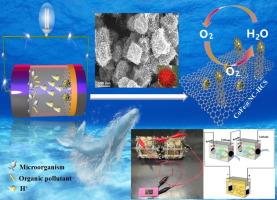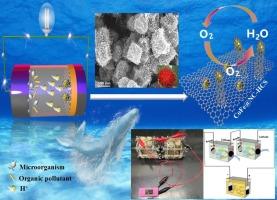微生物燃料电池同时高效发电和废水降解:放大碳壳局部电荷密度和限制氧还原反应中空结构的协同效应
IF 9
1区 工程技术
Q1 ENGINEERING, CHEMICAL
引用次数: 0
摘要
中性微生物燃料电池(MFC)中的氧还原反应(ORR)缓慢,严重限制了废水的发电和降解。碳包覆合金和空心结构的约束效应促进了ORR中的电子转移和氧输运,但揭示它们的协同作用和合金芯在表面n掺杂碳位上的机制仍然是一个很大的挑战。本文提出了一种配体交换诱导的双金属-有机框架(mfs, ZIF-8@CoFe PBA)前驱体,用于合成一种类似rambutan的电催化剂(CoFe@NC-HCS),该催化剂由n掺杂碳纳米管(CNT)包裹的CoFe颗粒在空心纳米笼上生根。丰富的微/介孔有助于电解质的渗透和传质,密度泛函理论(DFT)计算表明,CoFe提高了o中间体的n掺杂碳壳的局域电荷密度。因此,CoFe@NC-HCS的半波电位为0.128 V,高于PBS溶液中Pt/C的半波电位。CoFe@NC-HCS阴极MFC的最大功率密度可达2627 ± 53 mW·m−2,COD去除率为91.54 %。MFCs可以成功地驱动电子表,也可以为苯酚的电吸附提供动力,去除率为92.3 %。本研究为ORR催化的工程耦合约束结构和包裹金属对碳壳的影响提供了新的视角。本文章由计算机程序翻译,如有差异,请以英文原文为准。


Efficient electricity generation and wastewater degradation simultaneously in microbial fuel cell: Synergistic effect of amplifying localized charge density of carbon shell and confinement of hollow structures for oxygen reduction reaction
The sluggish oxygen reduction reaction (ORR) in neutral microbial fuel cell (MFC) significantly limits the electricity generation and degradation of wastewater. Confinement effects of carbon-encapsulated alloy and hollow structure facilitate electrons transfer and O2 transport in ORR, but unrevealing their collaborative interaction and the mechanism of alloy cores on the superficial N-doped carbon sites remains a great challenge. Here, a ligand exchange-induced dual metal–organic-frameworks (MOFs, ZIF-8@CoFe PBA) precursor is proposed to synthesize a rambutan-like electrocatalyst (CoFe@NC-HCS) of N-doped carbon nanotubes (CNT)-encapsulated CoFe particles rooting on hollow nanocages. The abundant micro/mesopores contribute to electrolyte penetration and mass transfer, and density functional theory (DFT) calculations indicate that CoFe improves the localized charge density of N-doped carbon shell for O-intermediates. Consequently, CoFe@NC-HCS exhibits a higher half-wave potential of 0.128 V than that of Pt/C in PBS solution. The maximum power density of MFC with CoFe@NC-HCS cathode reaches up to 2627 ± 53 mW·m−2 and COD removal efficiency is 91.54 %. MFCs can drive a digital watch successfully and also power electroadsoption of phenol with a removal ratio of 92.3 %. Our study offers a new insight into engineering coupled confinement structures and the effect of encapsulated metal on carbon shell for ORR catalysis.
求助全文
通过发布文献求助,成功后即可免费获取论文全文。
去求助
来源期刊

Separation and Purification Technology
工程技术-工程:化工
CiteScore
14.00
自引率
12.80%
发文量
2347
审稿时长
43 days
期刊介绍:
Separation and Purification Technology is a premier journal committed to sharing innovative methods for separation and purification in chemical and environmental engineering, encompassing both homogeneous solutions and heterogeneous mixtures. Our scope includes the separation and/or purification of liquids, vapors, and gases, as well as carbon capture and separation techniques. However, it's important to note that methods solely intended for analytical purposes are not within the scope of the journal. Additionally, disciplines such as soil science, polymer science, and metallurgy fall outside the purview of Separation and Purification Technology. Join us in advancing the field of separation and purification methods for sustainable solutions in chemical and environmental engineering.
 求助内容:
求助内容: 应助结果提醒方式:
应助结果提醒方式:


